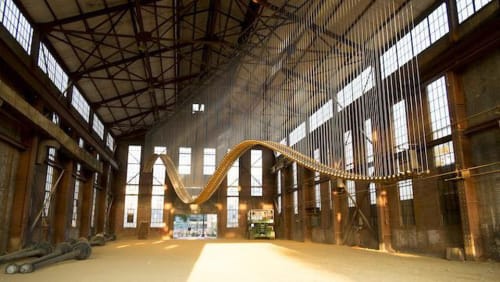Glenn Kaino’s Bridge is one of the most powerful pieces of art in recent history. Comprised of a series of fiberglass casts painted of gold from the raised fisted arm of Tommie Smith, the 1968 Olympic gold medalist who raised his fist in solidarity with the Civil Rights Movement after winning the 200 M dash. Last year I had the opportunity to interview both Kaino and Smith for Al Jazeera America about the piece and about that moment at Chicago Expo, the first stop where the work in progress was unveiled before stops at the Studio Museum in Harlem and the Naval Building in Washington, D.C., where it is currently displayed in its final iteration just minutes away from the country’s policymakers as part of The 5X5 Project.
I caught up with Kaino on the phone on the day that it opened in D.C. and asked him what it meant for him to be showing Bridge in the capital. “We [Tommie Smith and Kaino] were talking about that yesterday,” said Kaino. “To me in the capital, in terms of the importance of raising this dialogue, in a region of policymakers is something that’s very vital, especially now in context with what’s going on not only in the world, but here in the country. I think that since we last spoke Ferguson has happened and there’s a whole new context of challenges in the international realm as well.“
Now, thanks to Kaino’s work and the racial turmoil in Ferguson that occurred as a result of the shooting of 18-year-old Michael Brown in Ferguson, Smith’s arm still has relevance nearly 50 years after his iconic gesture. Kaino even went to Ferguson when he was in nearby St. Louis for an opening of an exhibition of his Burning Boards at the World Chess Hall of Fame.
“I ended up driving over to Ferguson for two days and spending some time with the activists there, and having dialogue with them about understanding and hearing their stories, just sort of listening and knowing that I was going to open this project in a week later and understanding what I heard a lot was phrases like ‘A lot seems to have changed, but nothing has changed,’” said Kaino.
The ever curious Kaino just listened to what the residents and the media had to say about the recent strife just weeks after it had become the focal point of the media, thinking about the connection between the bridge and the incidents there.
Kaino described the effect the bridge has on its viewers. “You see their footsteps below this monument implicating them and their own travels around the piece,” said Kaino. “People end up traveling in a circular motion around this piece, so there are a lot of ways that it really works to develop a dialogue, and the procession on the street when we’ve been installing has been remarkable, the amount of engagement and dialogue that has happened because of it.”
On September 19, Kaino has an exhibition opening in Chicago titled Leviathan at Kavi Gupta. For this exhibition Kaino collected rocks from Ferguson, Cairo and people he knew in Afghanistan, Athens, Syria, and Israel — various locales around the globe that are going through political turmoil. “When an activist throws it and it’s in the air that’s when it’s alive and when it has vitality,” said Kaino, who three the rocks against objects. “They’re these very high polished stainless steel objects that are shaped in the form of windows of international U.S. embassies, but I’ve thrown the rocks at them, and there are beautiful, liquefying dents on them,” he explained.
For Kaino, his work is “really about asking more questions than it is about conveying a message.” Take a look at Kaino’s thought-provoking work. What does it make you think about?
“It’s almost looking into a portal into the past to allow us to then chart what our present looks like, and if we can look successfully into the past as to not repeat future, how do I find that, and how do I try to reconcile that in the present?” asked Kaino.
